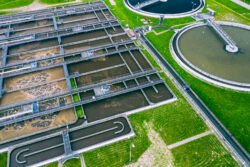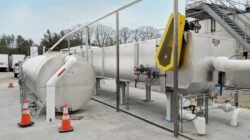
Multistage Centrifugal Pump: Enhancing Efficiency in High-Pressure Applications
Multistage centrifugal pumps are powerful machines used in many industries. They move liquids by using multiple impellers to increase pressure. These pumps can handle high flow rates and lift fluids to great heights, making them crucial for tasks like water supply and oil extraction.
These pumps work by dividing the total head into smaller parts. Each stage adds energy to the fluid, allowing it to reach higher pressures. This design makes multistage centrifugal pumps very efficient for moving large volumes of liquid over long distances or to high elevations.
Engineers choose multistage centrifugal pumps when single-stage pumps can’t meet the job’s needs. They are common in water treatment plants, irrigation systems, and industrial processes. Their ability to work under high pressures makes them ideal for challenging pumping tasks.
Key Takeaways
- Multistage centrifugal pumps use multiple impellers to achieve high pressures and flow rates
- These pumps are essential in industries requiring fluid transport over long distances or to great heights
- Regular maintenance and proper selection are key to ensuring optimal performance of multistage centrifugal pumps
Fundamentals of Multistage Centrifugal Pumps
Multistage centrifugal pumps use multiple impellers to boost fluid pressure and flow. They are designed to handle high-pressure applications and can achieve greater head heights than single-stage pumps.
Principles of Operation
Multistage centrifugal pumps use two or more impellers in series to increase fluid pressure. As fluid enters the pump, the first impeller adds energy and pushes it to the next stage. Each subsequent impeller further increases the pressure.
The stages work together to create higher discharge pressures than a single impeller could achieve alone. This allows multistage pumps to move fluids to greater heights or overcome high system pressures.
Impellers can be arranged on a single shaft or on separate shafts connected by couplings. The number of stages depends on the required pressure boost. More stages result in higher pressures but also increased power consumption.
Components and Construction
Key components of multistage centrifugal pumps include:
- Casing: Houses impellers and guides fluid flow
- Impellers: Rotating parts that add energy to the fluid
- Shaft: Connects and rotates the impellers
- Bearings: Support the rotating shaft
- Seals: Prevent fluid leakage
- Wear rings: Reduce internal leakage between stages
The pump casing is typically split horizontally or vertically for easy maintenance access. Impellers are usually made of stainless steel or bronze for corrosion resistance.
Stages are connected in series, with the discharge of one feeding the inlet of the next. Guide vanes or diffusers between stages help direct flow and improve efficiency.
Design and Manufacturing
Multistage centrifugal pump design and manufacturing involve careful planning and precise execution. The process requires attention to detail in both the design phase and production methods.
Design Considerations
Multistage centrifugal pump design focuses on creating efficient and reliable pumps for high-pressure applications. Engineers must consider factors like flow rate, head, and power requirements.
The number of stages is a key decision. More stages allow for higher pressure output but increase pump size and cost. Impeller design is crucial for optimal performance. Proper impeller shape helps avoid cavitation and wear.
Material selection is vital. Pump parts must withstand high pressures and resist corrosion. Common materials include stainless steel, cast iron, and bronze.
Shaft design is another important aspect. It must be strong enough to handle the load from multiple impellers. Bearings and seals need careful placement to prevent leaks and ensure smooth operation.
Manufacturing Processes
Multistage centrifugal pump manufacturing involves several steps. The process starts with casting or forging major components like the casing and impellers. Precision machining follows to ensure tight tolerances.
Quality control is essential throughout production. Manufacturers use techniques like non-destructive testing to check for defects. Assembly requires skilled technicians to properly align and balance all components.
Testing is a critical final step. Pumps undergo performance tests to verify they meet design specifications. This includes checking flow rates, pressure output, and efficiency.
Many pump manufacturers use computer-aided design (CAD) and computer-aided manufacturing (CAM) systems. These tools help improve accuracy and speed up production. Some companies also employ 3D printing for prototyping or making custom parts.
Types of Multistage Centrifugal Pumps
Multistage centrifugal pumps come in two main types: horizontal and vertical. These pumps use multiple impellers to increase pressure and handle high-head applications. Each type has unique features and benefits for different industrial uses.
Horizontal Multistage Centrifugal Pumps
Horizontal multistage centrifugal pumps are designed for high-pressure applications. They have a horizontal shaft with impellers arranged in series. These pumps are ideal for boiler feed, reverse osmosis, and high-pressure cleaning systems.
Key features of horizontal pumps include:
- Easy maintenance due to accessible components
- Compact design for space-constrained areas
- Ability to handle high flow rates and pressures
Horizontal pump manufacturers offer various models for different industries. These pumps can be customized for specific needs, such as corrosive fluid handling or high-temperature operations.
Vertical Multistage Centrifugal Pumps
Vertical multistage centrifugal pumps have a vertical shaft with stacked impellers. They are commonly used in water supply, irrigation, and pressure boosting applications.
The working principle of vertical pumps involves fluid entering at the bottom and moving upwards through each stage. This design offers several advantages:
- Smaller footprint compared to horizontal pumps
- Self-priming capabilities
- Efficient operation in deep well installations
Vertical pumps are often chosen for their reliability and energy efficiency. They can handle a wide range of flow rates and pressures, making them versatile for various industrial applications.
Applications and Uses
Multistage centrifugal pumps are versatile machines used in various industries and settings. They excel at moving fluids over long distances and at high pressures. These pumps are crucial in many processes that require consistent fluid flow and pressure.
Industry-Specific Applications
Oil and gas industries rely heavily on multistage centrifugal pumps. They use these pumps for oil extraction and transportation. In refineries, the pumps move crude oil through different processing stages.
Water treatment plants employ these pumps to move large volumes of water. They help in filtration, purification, and distribution processes.
Mining operations use multistage centrifugal pumps to remove groundwater from mines. They also help in transporting slurries over long distances.
In power plants, these pumps play a key role in boiler feed systems. They move water at high pressures into steam generators.
General Use Cases
Multistage centrifugal pumps are used in high-rise buildings for water supply. They provide consistent water pressure to all floors, even in tall structures.
Irrigation systems in agriculture benefit from these pumps. They can move water from deep wells or distant sources to crop fields.
Municipal water supply networks use these pumps to maintain pressure in pipelines. This ensures water reaches homes and businesses efficiently.
Fire protection systems often incorporate multistage centrifugal pumps. They provide the high pressure needed for effective firefighting in large buildings or industrial complexes.
Maintenance and Troubleshooting
Proper care and attention are crucial for keeping multistage centrifugal pumps running smoothly. Regular maintenance prevents breakdowns, while quick troubleshooting resolves issues promptly.
Routine Maintenance
Reliability centered maintenance is key for multistage centrifugal water pumps. Daily checks include:
- Inspecting for leaks
- Monitoring vibration and noise levels
- Checking bearing temperatures
Weekly tasks involve lubricating bearings and cleaning filters. Monthly, technicians should:
• Examine shaft seals
• Check coupling alignment
• Test safety devices
Annually, a full pump overhaul is recommended. This includes:
- Disassembling the pump
- Inspecting all components
- Replacing worn parts
- Reassembling and testing
Keeping detailed maintenance records helps track pump performance over time.
Common Issues and Solutions
Cavitation is a frequent problem in multistage centrifugal pumps. It occurs when inlet pressure drops too low, causing vapor bubbles to form and collapse. Signs include noise, vibration, and reduced performance. Solutions involve:
- Increasing inlet pressure
- Reducing fluid temperature
- Adjusting impeller design
Seal failures can lead to leaks. Causes include:
• Improper installation
• Misalignment
• Wear and tear
To fix, replace the seal and address any underlying alignment issues. Impeller damage from debris can reduce efficiency. Regular cleaning and installing proper inlet strainers help prevent this problem.
Advancements and Future Trends
Multistage centrifugal pumps are evolving rapidly. New materials and designs are making them more efficient and durable.
3D printing is changing how pump parts are made. This allows for more complex shapes and faster production times.
Smart sensors are being added to pumps. These can detect problems early and help prevent breakdowns.
Energy efficiency is a key focus. Newer pumps use less power while still delivering high performance.
Some key trends include:
- Use of composite materials
- Integration with IoT systems
- Advanced control algorithms
- Variable speed drives
Artificial intelligence and machine learning are starting to play a role in pump design and operation. These technologies can optimize pump performance in real-time.
Water scarcity is driving innovation in pump technology for desalination plants. Engineers are working on pumps that can handle high-salinity water more effectively.
As industries push for greener solutions, pump manufacturers are developing more environmentally friendly designs. This includes pumps that work well with renewable energy sources.
Frequently Asked Questions
Multistage centrifugal pumps are complex machines with unique features and applications. These pumps offer high pressure capabilities and efficient operation in various industries.
How does a multistage centrifugal pump work?
A multistage centrifugal pump has multiple impellers in series. Each impeller boosts the fluid pressure. The fluid moves from one stage to the next, gaining pressure at each step.
This design allows the pump to achieve higher pressures than single-stage pumps. The number of stages can vary based on the required output pressure.
What distinguishes a single-stage centrifugal pump from a multistage centrifugal pump?
Single-stage pumps have one impeller, while multistage pumps have several. Multistage pumps can produce higher pressures and handle greater head requirements.
Single-stage pumps are simpler and cheaper. Multistage pumps are more complex but offer better performance for high-pressure applications.
What are the applications of multistage centrifugal pumps?
Multistage centrifugal pumps are used in many industries. They excel in high-pressure water supply systems and boiler feed applications.
These pumps are common in oil and gas, mining, and chemical processing. They also play a key role in desalination plants and irrigation systems.
What are the typical disadvantages or limitations of using multistage centrifugal pumps?
Multistage pumps are more expensive than single-stage models. They have more complex designs, leading to higher maintenance costs.
These pumps can be larger and heavier, making installation challenging. They may also consume more power due to their high-pressure capabilities.
How can the performance of a multistage centrifugal pump be determined or evaluated?
Pump performance is assessed using pump curves. These graphs show the relationship between flow rate, head, and efficiency.
Key parameters include the Best Efficiency Point (BEP) and Net Positive Suction Head Required (NPSHR). Regular monitoring of these factors helps maintain optimal performance.
In what ways do vertical and horizontal multistage centrifugal pumps differ?
Vertical pumps have a smaller footprint, making them ideal for tight spaces. They’re often used in deep well applications and have better NPSH performance.
Horizontal pumps are easier to maintain and inspect. They’re suitable for high-flow, high-pressure applications in industrial settings.


